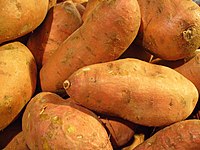
Photo from wikipedia
Purple sweet potato is known as a rich source of protein and anthocyanins. Anthocyanins can form complexes with protein present in food products through non-covalent forces or covalent bonds during… Click to show full abstract
Purple sweet potato is known as a rich source of protein and anthocyanins. Anthocyanins can form complexes with protein present in food products through non-covalent forces or covalent bonds during processing, transportation and storage as their protein affinity. We evaluated the hypoglycemic effects of p-BAC-PSP and free anthocyanin compounds of purple sweet potato (FAC-PSP) in HFD/STZ-induced diabetic mice. The results showed administration of both p-BAC-PSP and FAC-PSP improved diabetic condition, as evidenced by the improvement of glucose tolerance and lipid metabolism, and the decrease of oxidative stress and liver damage. For the mechanism study, we have found that p-BAC-PSP and FAC-PSP induced the expression of AMP-activated protein kinase (AMPK) in liver. With p-BAC-PSP or FAC-PSP treatment, glucose transporter type 2 (GLUT2), the protein levels of glucokinase (GK), and insulin receptor α (INSR) were found to be improved significantly (p < 0.05). Glycolysis key genes, phosphofructokinase (PFK), pyruvate kinase (PK), were up-regulated in two treatment groups, while gluconeogenic genes, glucose-6-phosphatase (G6Pase) and phosphoenolpyruvate carboxykinase (PEPCK), were down-regulated. Our findings suggested that p-BAC-PSP has great potential as a dietary supplement with hypoglycemic activities for general, pre-diabetic and diabetic population.
Journal Title: Journal of agricultural and food chemistry
Year Published: 2020
Link to full text (if available)
Share on Social Media: Sign Up to like & get
recommendations!